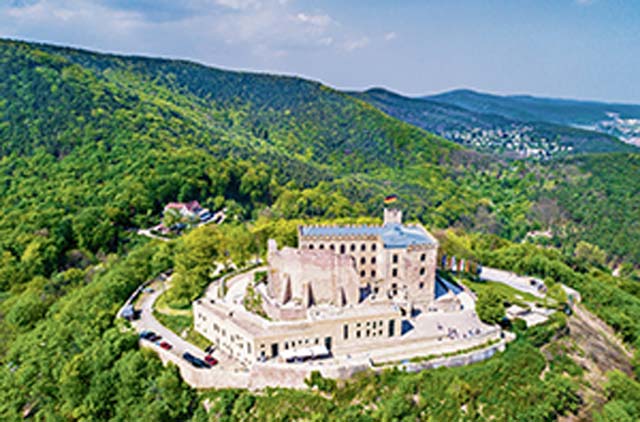
Many in the Kaiserslautern Military Community may already be familiar with cozy Neustadt/Weinstrasse with its small alley ways and semi-timbered medieval buildings, its spacious market square with St. Ägidius Church and picturesque courtyards where you can sip a glass of wine.
But, did you know that Neustadt also has a section up on a hill surrounded by vineyards? And, that it houses a castle with great historical significance in German and European history?
Hambach Castle and its history are regarded as the “cradle of German democracy” and the first black, red and gold flag was hoisted there on May 27, 1832. At that time about 30,000 people gathered on the mountain to advocate for a rule of law, national unity, civil liberties, and European solidarity. The event that drew men and women of all classes demanding freedom of expression, freedom of the press and freedom of association became known as the Hambach Festival and was the first step on a long road to the development of German and European democracy.
The year 1816 brought about significant territorial changes to (today’s) Rheinland-Pfalz region and was transferred to the King of Bavaria. At that time, Germany was split into a number of smaller kingdoms or duchies, and people lacked a sense of unity.
Failed harvests threatening the existence of farmers and wine growers in a mainly agricultural area plus customs regulations for exports (to homeland Bavaria) eventually led to unrest by the 1830s. In addition, political, economic and widespread social discontent contributed to the great mobilization of the Hambach Festival.
Critical opinions and political demands were censored, and journalists and lawyers called for a united German state and constitution. The most important initiative that led to the Hambach Festival was the “German Fatherland Association in Support of Free Press” with its two main goals national unity and freedom of the press.
The association was founded in January 1832 and quickly gained momentum. Friedrich Schüler, head of the liberal opposition in Bavarian parliament, was successful in limiting Bavaria’s policy of censorship. Journalist Jakob Siebenpfeiffer and others joined the association, which quickly grew to 5,000 members, many of them from Neustadt.
Originally a celebration in honor of the Bavarian constitution was planned at Hambach Castle on May 26, 1832. On short notice Siebenpfeiffer rededicated the event and instead spread a public petition and extended an invitation to a “Festival of Hope” on May 27, intended to “shake off inner and outer violence and strive for lawful freedom and German national dignity.”
The petition was signed by 32 citizens of Neustadt who organized the festival. The Bavarian government’s attempt to stop the festival with a ban backlashed due to the journalistic outcry of the liberal-democratic opposition and unintentionally even led to further mobilization of citizen discontent with the political, economic and social situation.
Siebenpfeiffer explicitly invited and encouraged women to actively participate in the event, something that was by no means a matter of course at the time. The invitation read: “German women and maidens, whose political disregard in the European order is a mistake and a stain, adorn and enliven the gathering with your presence!”
Many women accepted the invitation and for most of them, it would have been the first time they took part in a political gathering. The Hambach Festival thus also marks an important step at the start of the long road to politically mobilizing women in Germany.
The festival turned out to be more of a colorful folk fest than a political gathering. Thousands accepted the invitation, there were stalls and carts selling bread, sausage, beer and wine, and even carousels were set up for three lively days.
A procession started at the market square in Neustadt in the morning and moved up the hill with the participants shouting “Hinauf, hinauf auf’s Schloss!” A Neustadt civil guard headed the procession and was flanked by a large group of women. Students with pamphlets demanding democracy mingled in the crowd, while Johann Philipp Abresch, a businessman from Neustadt, carried a very special flag and hoisted it on the tower of the castle ruins for all to see.
The flag was evenly colored with stripes in black, red and gold, and had an inscription “Deutschland’s Wiedergeburt” (Germany’s rebirth) stitched in the middle red strip. This original flag can be seen at the permanent exhibit “Up, up to the Castle!” and to present these colors stand for a free, democratic and unified Germany.
The Hambach Festival brought people together from both near and far. Most came from the surrounding area, but many also came from Bavaria, Württemberg, the Rhine Province, Poland, and France. They wanted the creation of a nation state, as well as mutual understanding between European nations.
There were twenty speakers throughout the event and Johann Wirth ended his with this final note: “Cheers! Three cheers for the Confederate of Europe!” He was expressing the solidarity of all peoples who fought for their freedom and national independence. This may have been the seed that implanted the idea of a unified Europe and creation of the European Union 160 years later.
The European Union currently has 27 member nations and 448 million inhabitants. This year the election for the European Parliament in Strasbourg will take place on June 9.
The vibrant site and magnificent castle that marks the history of democracy is open to visitors and features the permanent exhibit “Up, up to the Castle!”, a colorful Lego scene and interactive elements to explore in depth. The event program that includes political discussions, classical concerts, cabarets, and plays for children and adults offers just as much cultural entertainment as do lively debates. The castle garden, the Mediterranean-like panorama terrace, and Restaurant 1832 invite visitors to stroll around, discover, and enjoy. The castle garden, restaurant and castle are barrier-free.
The Hambacher Musikfest takes place from May 29 to June 2 in the castle itself, and the folk fest in Hambach “Schwarz-Rot-Gold” from June 14 to 16. https://hambacher-schloss.de/entdecken/hambacher-schloss-2


